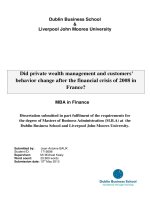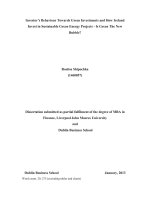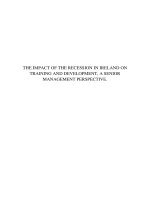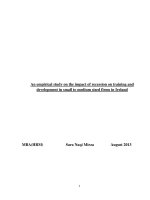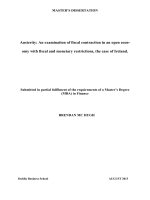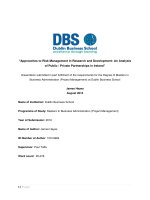Master Thesis in Economics: Green marketing and country of origin effects - A comparative analysis between the American and Swedish consumer market
Bạn đang xem bản rút gọn của tài liệu. Xem và tải ngay bản đầy đủ của tài liệu tại đây (19.07 MB, 131 trang )
University of Wales Ð Dublin Business School
MSc International Business
Dissertation
Word Count: C. 22,000
Green Marketing and
Country of Origin Effects Ð
A comparative analysis between the American and Swedish consumer market
Asmundsson, Christoffer
Student Nr. 0911867200266 / 1561211
January 2012
Green Marketing and Country of Origin Effects
DISSERTATION SUBMISSION - CANDIDATE'S CHECKLIST
(a)
Matriculation procedure has been completed. If required, a
Matriculation form has been bound into the dissertation.
(b)
Three copies of dissertation typed and bound.
(c)
A compact disk containing a digital copy of the dissertation.
(d)
The Declaration and Statements Form has been completed and bound
into the dissertation.
(e)
The Dissertation summary (Abstract) is completed and bound into the
dissertation.
(f)
A copy of the Notice of Candidature Form completed and bound into
the dissertation.
(g)
If necessary, a payment has been made for the resubmission of the
dissertation.
(h)
Copies of all primary research material have been included either in hardcopy
or softcopy. Softcopy should be on the same CD as the dissertation itself.
Hardcopy should be securely stapled and not bound into the dissertation.
(i)
(b)-(h) submitted to Program Director or other member of the
Department staff designated for the purpose of processing the
dissertation.
PLEASE NOTE THAT IF ANY OF THE ABOVE ARE OMITTED
THERE WILL BE A DELAY IN THE EXAMINATION
OF YOUR DISSERTATION
ii
Copyright © 2012 Christoffer Asmundsson
Green Marketing and Country of Origin Effects
iii
Copyright © 2012 Christoffer Asmundsson
Green Marketing and Country of Origin Effects
Statements & Declarations
iv
Copyright © 2012 Christoffer Asmundsson
Green Marketing and Country of Origin Effects
Application for Matriculation as a Postgraduate Student (page 1 out of 2)
This form must be completed by candidates applying to register for higher degrees and university postgraduate
diplomas and returned to the Validation Unit, University of Wales Registry, Cathays Park, Cardiff CF10 3NS, before
the commencement of study.
Candidates for MasterÕs degrees and University postgraduate diplomas and certificates may matriculate on the
basis of holding a recognized degree or equivalent professional qualification. The University may also approve the
admission of non-graduates whose relative lack of formal qualifications is compensated for by substantial relevant
experience. The University has established protocols for the matriculation of non-graduate entrants to particular types
of study. Such a candidate must have held a position of responsibility of relevance to the proposed scheme of study for
an acceptable period of time. Irrespective of a candidateÕs entry qualifications, the University must be satisfied that
he/she is of the required academic standard to complete the scheme of study proposed.
It is desirable though not a requirement of entry that candidates applying to register on an MBA have 2 years
relevant and responsible experience in addition to the above mentioned entry requirements.
Please indicate, by ticking the appropriate box, the basis of your admission to your postgraduate scheme of study:
Degree/Professional Qualifications
Now complete section A, B & D
(A)
AND/
OR
Forename:
Christoffer
Surname:
Asmundsson
University Student Number:
1561211 for DBS & 0911867200266 FOR University of Wales
Title:
Green Marketing and Country of Origin Effects Ð A comparative
analysis between the American and Swedish consumer market
✔
Date of Birth:
November 26th 1986
DELIVER TO:
Title of Degree:
MSc
Title of Course:
International Business
Start Date of Course:
27/09/2010
Length of Course:
16 months
•sa Asmundsson
Dag Hammarskjšlds VŠg 5J
224 64 Lund
Sweden
The outcome of an application will be sent to the
Institution unless an application has been made
independently
Mode of Study:
Full-Time
Awarding Body & Country of Study
Now complete section A, C and D
Address:
Institution you will be studying at:
Dublin Business School
(B)
Relevant Responsible Experience
Dates
Study
Undertaken:
Title of Qualification:
Original degree certificates must be enclosed (which will be returned)
Photocopies will be accepted if the original degree certificate has been seen by a member of staff at the institution in which you intending
to undertake your studies and the copy has been signed by the staff member.
v
Copyright © 2012 Christoffer Asmundsson
Green Marketing and Country of Origin Effects
Application for Matriculation as a Postgraduate Student (page 2 out of 2)
(C)
Age on first day of entry to postgraduate study
23
years
10
months
Please provide brief details of relevant professional experience in the space provided (a full CV and references from previous employers
should also be attached)
Date:
Position:
2011/06&–&Present&
&
&
&
&
&
&
&
&
&
&
&
&
&
Ugglebo& Clogs& LLC& –& Supply& Chain&
Manger&Intern,&MN,$USA$
$
$
$
$
$
$
$
$
$
$
$
$
&
Nationellbyggen&I&Skåne&AB&–&PartItime&
Internal&Consultant,!Sweden$
&
2008/02–&2011/05&
2010/01&–&2010/06
Responsibilities:
Letcat& –& External& Consultant& Intern,$
Sweden
¥
¥
¥
¥
&
¥
Counseling&and&advisor&in&strategy,&marketing&and&
a&potential&merger&&&acquisition$
¥
Project& leader& for& a& team& of& five& external&
consultant&interns&
Marketing&strategy&and&planning&for&the&launch&of&
the&injector&Rogue&(now&Letject®)&&
Market& analysis& and& research& of& potential& target&
groups&and&therapy&areas&
¥
¥
2009/10&–&2009/12&
2009/02&–&2009/04&
Abacus& Sportswear& AB& –& External&
Consultant&Intern,&Sweden
¥
Researched& the& perception& of& the& Abacus& brand&
and& the& possibilities& of& market& penetration&
through&concept&stores&
Strategy& and& analyses& through& conducted&
supporting&surveys&
Support&of&inIhouse&activities
¥
Managed&the&footwear&and&outdoor&department
¥
¥
2003/08&–&2006/12
Stadium& (Novalund)& –& PartItime& Store&
Sales&Representative&
Implement&project&management&tools&to&improve&
communication& and& control& of& longIterm& and&
shortIterm&projects&
Decrease& domestic& logistic& costs& with& 10%& and&
provided& customers& with& better,& faster& and&
cheaper&delivery&options.&&
Improvement& of& operational& and& manufacturing&
efficiency& through& developing& and& implementing&
manufacturing&guidelines&
Implemented& a& Corporate& Social& Responsibility&
program&and&established&a&collaboration&with&the&
nonIprofit&organization&Pink&Ribbon&Riders&
&
&
For further support of the suitability of the researcher to conduct this research, see Appendix 5 Ð Suitability of
the Researcher.
vi
Copyright © 2012 Christoffer Asmundsson
Green Marketing and Country of Origin Effects
Abstract
This research investigates the current white spaces of green marketing and country of origin
effects, where new research could contribute theoretical value. The conducted research
examines American and Swedish consumersÕ environmental awareness, willingness and
initiative in contributing to their societies for future sustainability. Using a sample of 118
consumers from an intermediated questionnaire for the offline market, a conceptual
framework was developed where the study created the foundation and reasonable support for
the purposed framework. The research has put forth several findings that have both a
theoretical and managerial impact on organizationsÕ business models, that todayÕs companies
need to adopt to become successful in increasing sales of environmentally friendly products.
Specifically, it was found that consumers acknowledge the cost-benefit relation on a personal
level. Swedish consumers trust eco-labels to a greater extent than U.S. consumers, hence the
relation between country of origin and eco-labels, as a source of information that consumers
reflect upon, triggering a pro behavior. ItÕs evident that many of the triggering factors have a
social perspective, but it depends on the ability of brands and retailers to communicate
messages, as well as their efforts to carry larger assortments of environmentally friendly
products. Ultimately, green marketing can lead to competitive advantages alone if adopted,
and in addition to the ability of organizations to offer a product with a certain origin; it results
in a supporting feature that increases the state of competiveness.
Keywords: green marketing; green strategies; eco-labeling; country of origin
effects; risks; branding, behavior & values; research methodology
vii
Copyright © 2012 Christoffer Asmundsson
Green Marketing and Country of Origin Effects
Table of Contents
!
!
viii
Copyright © 2012 Christoffer Asmundsson
Green Marketing and Country of Origin Effects
ABSTRACT!....................................................................................................................................................!VII!
ACKNOWLEDGMENT!..................................................................................................................................!XV!
CHAPTER!1!–!INTRODUCTION!...................................................................................................................!1!
1.1!BACKGROUND!..............................................................................................................................................................!2!
1.1.1#Personal#interest#in#the#research#topic#......................................................................................................#3!
1.2!STATEMENT!OF!RESEARCH!QUESTIONS!&!CONTRIBUTIONS!...............................................................................!3!
1.3!APPROACH!...................................................................................................................................................................!5!
1.4!SCOPE!AND!LIMITATIONS!..........................................................................................................................................!5!
1.5!DISPOSITIONS!..............................................................................................................................................................!6!
CHAPTER!2!–!LITERATURE!REVIEW:!GREEN!MARKETING!..............................................................!7!
2.1!CURRENT!LITERATURE!CHARACTERISTICS!............................................................................................................!8!
2.2!THE!STARTING!POINT!FOR!THE!GREEN!MARKETING!CONCEPT!...........................................................................!8!
2.3!THEORY!OF!CUSTOMERS’!BEHAVIOR!LINKED!TO!ENVIRONMENTAL!ATTITUDES!...........................................!10!
2.4!THE!CONCEPT!OF!GREEN!MARKETING!..................................................................................................................!11!
2.4.1#Eco5labeling#........................................................................................................................................................#15!
2.4.2#Green#branding#.................................................................................................................................................#17!
2.5!RISKS!OF!GREEN!MARKETING!.................................................................................................................................!17!
2.6!THE!IMPORTANCE!FOR!COMPANIES!TO!BECOME!GREEN!....................................................................................!18!
2.6.1#Developed#vs.#the#developing#world#.........................................................................................................#19!
2.7!CONSUMER!PREFERENCE!FOR!GREEN!APPAREL!PRODUCTS!..............................................................................!19!
2.8!THE!CASE!OF!THE!PATAGONIA!COMPANY!............................................................................................................!21!
2.8!SUMMARY!AND!CONCLUSION!OF!THE!LITERATURE!REVIEW!.............................................................................!24!
CHAPTER!3!–!LITERATURE!REVIEW:!COUNTRY!OF!ORIGIN!EFFECTS!.......................................!26!
3.1!EMERGING!RESEARCH!AREA!...................................................................................................................................!27!
3.2!COUNTRY!OF!ORIGIN!EFFECTS!................................................................................................................................!28!
3.2.1#The#paradox#of#geographical#status#........................................................................................................#30!
3.3!THE!IMPORTANCE!OF!THE!TOPIC!...........................................................................................................................!30!
3.4!SUMMARY!AND!CONCLUSION!OF!THE!LITERATURE!REVIEW!.............................................................................!31!
CHAPTER!4!–!RESEARCH!METHODOLOGY!..........................................................................................!32!
4.1!METHODOLOGY!.........................................................................................................................................................!33!
4.1.1#Research#philosophy#.......................................................................................................................................#34!
4.1.2#Research#approach#..........................................................................................................................................#34!
4.1.3#Research#strategy#............................................................................................................................................#34!
4.1.4#Time#horizon#......................................................................................................................................................#36!
ix
Copyright © 2012 Christoffer Asmundsson
Green Marketing and Country of Origin Effects
4.2!SAMPLING!METHOD!..................................................................................................................................................!36!
4.2.1#Secondary#research#.........................................................................................................................................#36!
4.2.2#Primary#research#.............................................................................................................................................#36!
4.2.3#Sampling#method#.............................................................................................................................................#38!
4.2.4#Questionnaire#and#research#design#..........................................................................................................#39!
4.2.5#Reliability#and#Validity#of#using#the#Likert#scale#................................................................................#40!
4.2.6#Method#for#analysis#of#primary#research#..............................................................................................#42!
4.3!LIMITATIONS!AND!ISSUES!OF!THE!PRIMARY!RESEARCH!....................................................................................!43!
CHAPTER!5!–!FINDINGS!............................................................................................................................!44!
5.1!DEFAULT!SECTION!1:!DEMOGRAPHICS!................................................................................................................!45!
5.1.1#Question#1#–#Gender#........................................................................................................................................#45!
5.1.2#Question#2#–#Age#...............................................................................................................................................#46!
5.1.3#Question#3#–#My#gross#income#per#year#..................................................................................................#47!
5.1.4#Question#4#–#My#occupation#........................................................................................................................#48!
5.1.5#Question#5#–#Country#of#birth#and#residency#........................................................................................#49!
5.2!DEFAULT!SECTION!2:!DEMOGRAPHICS!................................................................................................................!51!
5.2.1#Question#1#–#Gender#........................................................................................................................................#51!
5.2.2#Question#2#–#Age#...............................................................................................................................................#52!
5.2.3#Question#3#–#My#gross#income#per#year#..................................................................................................#53!
5.2.4#Question#4#–#My#occupation#........................................................................................................................#54!
5.2.5#Question#5#–#Country#of#birth#......................................................................................................................#55!
5.3!COMPARATIVE!ANALYSIS!........................................................................................................................................!57!
5.3.1.#Question#6#–#Principles#that#guide#the#way#I#live#my#life#and#do#my#shopping#....................#57!
5.3.2#Question#7#–#How#I#value#my#choice#of#products#................................................................................#61!
5.3.3#Question#8#–#The#connection#between#the#environment#and#country#of#origin#....................#65!
5.3.4#Question#9#–#The#willingness#to#pay#higher#prices#for#eco#products#..........................................#69!
5.3.5#Question#10#–#My#purchase#intention#......................................................................................................#71!
CHAPTER!6!–!DISCUSSION!........................................................................................................................!76!
6.1!FINDINGS!....................................................................................................................................................................!77!
6.1.1#Green#Marketing#...............................................................................................................................................#77!
6.1.2#Country#of#Origin#Effects#...............................................................................................................................#78!
6.2!THE!FINDINGS’!CORRELATION!WITH!THEORIES!AND!CONCEPTS!......................................................................!78!
6.2.1#Green#marketing#...............................................................................................................................................#78!
6.2.2#Country#of#Origin#Effects#...............................................................................................................................#80#
x
Copyright © 2012 Christoffer Asmundsson
Green Marketing and Country of Origin Effects
CHAPTER!7!–!CONCLUSION!......................................................................................................................!81!
7.1!CONCLUDING!REMARKS!–!GREEN!MARKETING!...................................................................................................!82!
7.1.1#Triggering#factors#............................................................................................................................................#83!
7.1.2#Competitive#advantage#.................................................................................................................................#84!
7.2!CONCLUDING!REMARKS!–!COUNTRY!OF!ORIGIN!EFFECTS!................................................................................!84!
7.3!THE!EIGHT!TRUTHS!FRAMEWORK!........................................................................................................................!85!
CHAPTER!8!–!RECOMMENDATIONS!......................................................................................................!88!
8.1!FURTHER!RESEARCH!................................................................................................................................................!89!
REFERENCES!.................................................................................................................................................!91!
WORKS!CITED!..................................................................................................................................................................!92!
APPENDICES!.................................................................................................................................................!98!
APPENDIX!1!–!CHOOSING!ORGANIC!..............................................................................................................................!99!
APPENDIX!2!–!QUESTIONNAIRE!FORM!.....................................................................................................................!101!
APPENDIX!3!–!PARTICIPANTS’!TESTIMONIALS!........................................................................................................!107!
APPENDIX!4!–!POPULATION!PYRAMID!......................................................................................................................!110!
APPENDIX!5!–!SUITABILITY!OF!THE!RESEARCHER!.................................................................................................!111!
List of Charts
CHART!1!GENDER!OF!PARTICIPANTS!....................................................................................................................................................!45!
CHART!2!AGE!OF!PARTICIPANTS!............................................................................................................................................................!46!
CHART!3!INCOME!OF!PARTICIPANTS!.....................................................................................................................................................!47!
CHART!4!OCCUPATION!OF!PARTICIPANTS!............................................................................................................................................!48!
CHART!5!COUNTRY!OF!BIRTH!OF!PARTICIPANTS!................................................................................................................................!49!
CHART!6!COUNTRY!OF!RESIDENCY!OF!PARTICIPANTS!.......................................................................................................................!50!
CHART!7!GENDER!OF!PARTICIPANTS!IN!EACH!MARKET!.....................................................................................................................!52!
CHART!8!AGE!OF!PARTICIPANTS!IN!EACH!MARKET!.............................................................................................................................!53!
CHART!9!INCOME!OF!PARTICIPANTS!IN!EACH!MARKET!......................................................................................................................!54!
CHART!10!OCCUPATION!OF!PARTICIPANTS!IN!EACH!MARKET!..........................................................................................................!55!
CHART!11!COUNTRY!OF!BIRTH!OF!PARTICIPANTS!IN!EACH!MARKET!...............................................................................................!56!
CHART!12!PROTECT!THE!NATURE!.........................................................................................................................................................!58!
CHART!13!KEEP!A!BEAUTIFUL!WORLD!..................................................................................................................................................!59!
CHART!14!LIVING!IN!HARMONY!WITH!THE!NATURE!...........................................................................................................................!60!
CHART!15!THE!QUALITY!OF!THE!PRODUCT!IS!MOST!IMPORTANT!.....................................................................................................!61!
CHART!16!THE!ENVIRONMENTAL!IMPACT!OF!A!PRODUCT!IS!THE!MOST!IMPORTANT!....................................................................!62!
CHART!17!THE!PRICE!OF!THE!PRODUCT!IS!THE!MOST!IMPORTANT!..................................................................................................!63!
CHART!18!MY!PERSONAL!VALUES!ARE!THE!MOST!IMPORTANT!WHEN!I!CHOOSE!A!PRODUCT!......................................................!64!
xi
Copyright © 2012 Christoffer Asmundsson
Green Marketing and Country of Origin Effects
CHART!19!I!TRUST!ECOILABELS!EVEN!IF!I!DON'T!KNOW!WHAT!THEY!MEAN!OR!STAND!FOR!........................................................!66!
CHART!20!I!WOULD!RATHER!BUY!PRODUCTS!THAT!ARE!BENEFICIAL!FOR!THE!ENVIRONMENT!AND!BENEFIT!NEXT!THE!
GENERATION!...................................................................................................................................................................................!67!
CHART!21!THE!QUALITY!OF!THE!PRODUCT!DEPENDS!ON!WHICH!COUNTRY!IT!COMES!FROM!.......................................................!68!
CHART!22!PRODUCTS!FROM!MY!OWN!COUNTRY!HAVE!BETTER!QUALITY!THAN!OTHER!COUNTRIES!...........................................!69!
CHART!23!INCREASED!PRICE!RANGE!IN!PERCENTAGE!........................................................................................................................!70!
CHART!24!MY!PURCHASE!INTENTION!–!PRESERVE!THE!ENVIRONMENT!.........................................................................................!72!
CHART!25!MY!PURCHASE!INTENTION!–!LARGER!ASSORTMENT!........................................................................................................!73!
CHART!26!MY!PURCHASE!INTENTION!–!REUSED!MATERIAL!AND!HIGHER!PRICE!...........................................................................!75!
List of Figures
FIGURE!1!THE!GREEN!CONSUMPTION!PROCESS!...................................................................................................................................!11!
FIGURE!2!GENERIC!COMPETITIVE!ENVIRONMENTAL!STRATEGIES!....................................................................................................!13!
FIGURE!3!FOUR!GREEN!STRATEGIES!......................................................................................................................................................!15!
FIGURE!4!FRAMEWORK!FOR!ANALYZING!INDIVIDUALLY!PERCEIVED!COST!AND!BENEFITS!OF!PRODUCTS!..................................!20!
FIGURE!5!COUNTRY!OF!ORIGIN!EFFECTS!..............................................................................................................................................!29!
FIGURE!6!RESEARCH!ONION!....................................................................................................................................................................!33!
FIGURE!7!RESEARCH!ROAD!MAP!.............................................................................................................................................................!35!
FIGURE!8!THE!EIGHT!TRUTHS!OF!SUCCESSFUL!GREEN!MARKETING!...............................................................................................!86!
List of Images
IMAGE!1!QUESTION!9!I!INCREASED!PRICE!............................................................................................................................................!43!
List of Tables
TABLE!1!QUESTIONNAIRE!CONTENT!.....................................................................................................................................................!39!
TABLE!2!GENDER!OF!PARTICIPANTS!.....................................................................................................................................................!45!
TABLE!3!AGE!OF!PARTICIPANTS!............................................................................................................................................................!46!
TABLE!4!INCOME!OF!PARTICIPANTS!......................................................................................................................................................!47!
TABLE!5!OCCUPATION!OF!PARTICIPANTS!.............................................................................................................................................!48!
TABLE!6!COUNTRY!OF!BIRTH!OF!PARTICIPANTS!.................................................................................................................................!49!
TABLE!7!COUNTRY!OF!RESIDENCY!OF!PARTICIPANTS!........................................................................................................................!50!
TABLE!8!GENDER!OF!PARTICIPANTS!IN!EACH!MARKET!......................................................................................................................!51!
TABLE!9!AGE!OF!PARTICIPANTS!IN!EACH!MARKET!.............................................................................................................................!52!
TABLE!10!INCOME!OF!PARTICIPANTS!IN!EACH!MARKET!....................................................................................................................!54!
TABLE!11!OCCUPATION!OF!PARTICIPANTS!IN!EACH!MARKET!...........................................................................................................!55!
TABLE!12!COUNTRY!OF!BIRTH!OF!PARTICIPANTS!IN!EACH!MARKET!...............................................................................................!56!
TABLE!13!PROTECT!THE!NATURE!..........................................................................................................................................................!58!
TABLE!14!KEEP!A!BEAUTIFUL!WORLD!..................................................................................................................................................!59!
xii
Copyright © 2012 Christoffer Asmundsson
Green Marketing and Country of Origin Effects
TABLE!15!LIVING!IN!HARMONY!WITH!THE!NATURE!...........................................................................................................................!60!
TABLE!16!THE!QUALITY!OF!THE!PRODUCT!IS!MOST!IMPORTANT!......................................................................................................!61!
TABLE!17!THE!ENVIRONMENTAL!IMPACT!OF!A!PRODUCT!IS!THE!MOST!IMPORTANT!....................................................................!62!
TABLE!18!THE!PRICE!OF!THE!PRODUCT!IS!THE!MOST!IMPORTANT!...................................................................................................!63!
TABLE!19!MY!PERSONAL!VALUES!ARE!THE!MOST!IMPORTANT!WHEN!I!CHOOSE!A!PRODUCT!......................................................!64!
TABLE!20!I!TRUST!ECOILABELS!EVEN!IF!I!DON'T!KNOW!WHAT!THEY!MEAN!OR!STAND!FOR!........................................................!65!
TABLE!21!I!WOULD!RATHER!BUY!PRODUCTS!THAT!ARE!BENEFICIAL!FOR!THE!ENVIRONMENT!AND!BENEFIT!THE!NEXT!
GENERATION!...................................................................................................................................................................................!66!
TABLE!22!THE!QUALITY!OF!THE!PRODUCT!DEPENDS!ON!WHICH!COUNTRY!IT!COMES!FROM!........................................................!67!
TABLE!23!PRODUCTS!FROM!MY!OWN!COUNTRY!HAVE!BETTER!QUALITY!THAN!OTHER!COUNTRIES!...........................................!68!
TABLE!24!INCREASED!PRICE!RANGE!IN!PERCENTAGE!.........................................................................................................................!70!
TABLE!25!MY!PURCHASE!INTENTION!–!PRESERVE!THE!ENVIRONMENT!..........................................................................................!72!
TABLE!26!MY!PURCHASE!INTENTION!–!LARGER!ASSORTMENT!.........................................................................................................!73!
TABLE!27!MY!PURCHASE!INTENTION!–!REUSED!MATERIAL!AND!HIGHER!PRICE!............................................................................!74!
xiii
Copyright © 2012 Christoffer Asmundsson
Green Marketing and Country of Origin Effects
In dedication to my parents Ð
•sa and Johan
xiv
Copyright © 2012 Christoffer Asmundsson
Green Marketing and Country of Origin Effects
Acknowledgment
I would like to take this opportunity to express my gratitude to all of those who have given
me the opportunity to complete this research paper.
In particular, I would like to thank my supervisor, Dr. Chantal Ladias, for her dedication and
honesty to this research. Much has been learned through having access to her expertize,
knowledge and most of all the ideas that she has contributed with through her vast
experience. It has truly been a source of inspiration.
To Fredrik Eklund, who has been kind enough to proofread the final version of this research,
not only correcting grammar but also contributing with inspiration, ideas and improvements.
I would also like to extend extra gratitude to all of the respondents, who have taken the time
to complete my questionnaire. Without you, this research would not have been possible.
To my family, friends and everyone else who have supported me, thank you!
Christoffer Asmundsson
January 2012
xv
Copyright © 2012 Christoffer Asmundsson
Green Marketing and Country of Origin Effects
Chapter 1 Ð Introduction
The following chapter will present an introduction to the background of this dissertation; it
will outlay the contextual circumstances of the problem that have raised the importance of
green marketing as well as my personal interest in the subject. It will clarify the research
questions and the intended contributions of this research, and will further outline the
disposition of the paper as well as the scope and limitations of my research.
1
Copyright © 2012 Christoffer Asmundsson
Green Marketing and Country of Origin Effects
1.1 Background
Over the past decades several trends have started, where the acknowledgement of the
environment is one. Within the retail industry, it has brought attention to how goods are
manufactured, what materials are used and how distribution is conducted i.e. attention to the
entire marketing mix: all in the context of the environmental impacts Ð glaciers melting,
landfilling, impacts on the ozone layer, decreasing of agricultural land and pollution. It has
presented challenges for organizations concerning to what extent they should recognize
environmental issues, and has also brought organizational benefits such as competitive
advantage trough recognition. Environmental issues have not only brought attention to
industries but also awareness of consumers, which are the foundation and the relation to this
research paper.
The dissertation will be an extended version of my previous research paper and make
additional contributions by presenting the concept of environmentally friendly clothing
products. Little research has been done on how companies actually can use green marketing
and its practical techniques to increase their sales, specifically in the context of clothing
retailing (Phau & Ong, 2007). This indicates a lack of research in the field of green marketing
with my intended concentration. Moreover, there is also a lack of research regarding the risks
of green marketing. Meyer (2001) argues that the issues with green clothing are for example
that clothing wear is perceived as shapeless and colorless, which increases the complexity of
the buying process. It was found that there is an importance to the life style of a consumer
and how it fits with the social group, which could affect the first step of the buying process
where the appearance is taken into consideration
Mostafa (2007) acknowledges the complexity of the subject: it derives from consumersÕ
cynicism towards businesses, such as empty promises and unfulfilled benefits. This is
beneficial in the sense that it indicates that consumer behavior and their consciousness are big
factors for the field of green marketing, which need to be considered through my research
paper. Furthermore, Mainieri et al.Õs (2007) research postulates that the success of green
marketing is in the hands of consumers, and itÕs crucial to investigate consumersÕ reactions
and attitudes towards green marketing for companies to be successful.
OrsatoÕs (2006) research findings demonstrate that the current green marketing strategies that
companies are exercising are not sufficient enough to deal with the issues that Meyer (2001)
presented, and that further research could add a valid contribution through new findings.
2
Copyright © 2012 Christoffer Asmundsson
Green Marketing and Country of Origin Effects
1.1.1 Personal interest in the research topic
My curiosity of the green marketing area has developed over the years, since I first stumbled
upon the notion of it, but it wasnÕt truly capitalized until I saw the documentary 180¡ South.
This documentary follows the adventurer, Jeff Johnson who retraces the epic journey of his
two role models Yvon Chouinard and Doug Tompkins to Patagonia. Chouinard would later
establish the Patagonia Company, Black Diamond and Tompkins the North Face Ð all
clothing and accessories companies within the sport/adventure market. Chouinard and
Tompkins, who were both driven by the passion for climbing and surfing, are now above
anything else driven by the love for the raw nature, which they first experienced 1968 in
Patagonia (the vast region spanning over both Chile and Southern Argentina, South America)
and are using all their fortunes in trying to protect it from corporate exploitations and
footprints deriving from it.
One of the more successful companies in grasping the concept of environmentally friendly
products and the usage of green marketing is Patagonia: a company that disrupts the market
forces and uses them to their advantage through recognizing social responsibility and Ð most
of all Ð environmental issues. This is one of the reasons for their record sales during the entire
recession. Additionally, the personnel policies are something beyond the ordinary standards;
they have well-established supportive networks to generate work-life balance for their
employees and founded Ò1% for the planetÓ Ð an organization where businesses can sign up
to donate 1% of their revenues for environmental causes. Overall, PatagoniaÕs business
morals and ethics are something unusual, which is something I would like to be part of.
1.2 Statement of research questions & contributions
My main intention for this research paper is to answer the following research question:
ÒHow can green marking be used to increase the purchase of environmentally
friendly apparel products among consumers?Ó
Answering the stated research question will be achieved by examining three objectives,
starting with how consumers prefer to be approached by companies:
1. Are there specific factors in green products and green marketing that trigger
consumers to choose a green product over a conventional product?
3
Copyright © 2012 Christoffer Asmundsson
Green Marketing and Country of Origin Effects
This contribution could be beneficial for companies who are interested in pursuing
manufacturing of green products through providing them with new findings. The same would
be true for companies who already are using green marketing, and would create the
opportunity for them to explore new ideas. Subsequently it will ultimately tell them how to
trigger a positive reaction for environmentally friendly purchasing. In essence, it supports the
findings made by Mainieri et al.Õs (1997) research Ð to find specific factors that trigger
customers to choose a green product over a conventional product, and form a framework
since their research suggests that the choice is in the hands of the consumer. Additionally, it
indicates the direction of the primary research that needs to be undertaken.
This leads on to my second objective:
2. Are green marketing practices enough to create a competitive advantage and
increase sales?
Current research (e.g. Polonsky & Rosenberger III, 2001) concludes that by using green
marketing companies can gain competitive advantage. However, due to the diminutive
research made in the field of apparel, could this statement also be true for the apparel
industry? This question directly touches on earlier statements concerning OrsatoÕs (2006) and
MeyerÕs (2001) research where it can be assumed that todayÕs strategies are not sufficient.
Consequently it creates an opportunity for my research to add valid contributions through
new findings.
The two questions previously presented are the foundation for the next question:
3. Would it be possible to form a framework for green marketing practice by
understanding consumersÕ knowledge about how they perceive green products?
My overall intention and contribution to the green marketing field is thus: through the
findings form a framework for how companies with customer apparel products can increase
their sales of green products through an understanding of what appeals to consumers, which
would enable companies to exploit green marketing practices in the correct way. This would
make a positive impact and become a beneficial contribution, where marketers could focus
on the quality and the benefits of preserving the environment while being able to reach the
mainstream consumer, and at the same time educate their customers. A newly developed
framework with novel findings would have the potential to support companies in these
matters.
4
Copyright © 2012 Christoffer Asmundsson
Green Marketing and Country of Origin Effects
1.3 Approach
In order to achieve the objectives of this research paper a literature review has been
conducted to examine the theories and techniques of green marketing that are currently found
in the literature, and then complement this secondary research with an exploration of their
application in the primary research.
Additionally, a smaller case study, involving the California based outdoor clothing company
Patagonia, which is the leading company in this field, has been made. Little literature
concerning green marketing practices has a focus on apparel and where this case study (case
study in the sense that it constitutes secondary literature) can be very beneficial in
understanding how leading companies currently are using this topic to increase
environmental awareness among customers and ultimately increase sales.
In addition to the extensive secondary research, involving journals, academic literature and
current newspapers of the green marketing area I have undertaken a primary research and
made a comparative analysis between the offline Swedish and American consumer markets
by using an online questionnaire. This creates a possibility to discover potential differences
and similarities in their behavior and attitudes to understand what infers with consumersÕ
consumption behavior in the context of green apparel products.
1.4 Scope and limitations
A first matter in determining the scope of the study was choosing a field of study Ð green
marketing. Thus the literature review provided me with new angles and a connection towards
the field known as country of origin effects which become too great and obvious to disregard
Ð consequently the scope of the study increased and made it possible for my research to
continue within my research objectives.
Furthermore, the scope intended to span over the apparel segment of consumer products. The
amount of current and available literature specifically concentrated to apparel has been
limited. As a result it affected the literature review, consequently giving it a general overview
for several industries and countries without any specific targets. On the other hand it opened
up more opportunities to explore this through my primary research.
The international angle was limited to the American market (later referred as the U.S.
market) and the Swedish market. HofstedeÕs (1980), cited in Szewczak & Snodgrass (2002),
5
Copyright © 2012 Christoffer Asmundsson
Green Marketing and Country of Origin Effects
research suggests that, itÕs possible to carry out research in one country within a region and
obtain a valid result that can represent a whole regional or geographical area. The U.S.
represents Northern America as well as the British Isles, whereas Sweden represents the
Nordic Countries. This idea and approach is also supported by Trompenaars (1993), cited in
Szewczak & Snodgrass (2002).
1.5 Dispositions
To build on this first part of the paper, the introduction of my intended research, Chapter 2
will present the literature review of the green marketing field with its theories and techniques
that intend to justify my research topic, and this chapter will be divided into several
subchapters that intend to explain different angles on the topic. Chapter 3 will, as the
previous chapter, be concentrated on theories, and it will address the area of country of origin
effects, which was developed when researching the green marketing field. Chapter 4
introduces the proposed research methodology for the primary research. The chapter will
reflect on the used techniques for my research including the strengths and weaknesses of my
chosen methodology, and the activities carried out. It will also provide a brief discussion on
the validity and reliability of the chosen methodology. Chapter 5 will present the findings
made in the primary research and be followed by Chapter 6 that provides a discussion of how
the findings in the primary research relates to the literature review as well as my
interpretation of them. Chapter 7 will present the conclusion, which aims to conclude what
the findings mean for the chosen research area, how it transmits to the research questions, and
further determine how it relates to todayÕs business environment. The last chapter (Chapter
8) will present the recommendations for further research that would add on to my and other
current research.
6
Copyright © 2012 Christoffer Asmundsson
Green Marketing and Country of Origin Effects
Chapter 2 Ð Literature review: Green marketing
The following chapter will present the theories and techniques of green marketing that are
currently found in the in literature. It carries several themes such as current literature
characteristics, green marketing as a concept, risks of green marketing, strategies and so
forth. The chapter will end with a brief summary and conclusion of the literature review.
7
Copyright © 2012 Christoffer Asmundsson
Green Marketing and Country of Origin Effects
2.1 Current literature characteristics
Many conducted studies are characterized by a focus on green product development; packing,
environmental sustainability & performance etc. (e.g. Dangelico & Pujari 2010, Unruh &
Ettenson 2010); creating a green brand (e.g. Chen 2010, Chatterjee & Kay 2010); green
strategies (e.g. Vaccaro & Cohn 2010, Orsato 2006); green consumer behavior (e.g. Foxall
1995, Mainieri et al. 1997) and social responsibility (e.g. Garc’a-Rosell & Moisander 2008,
Luchas et al. 2010). Noteworthy is that even though all this research has different focus, as
they tend to cross subjects e.g. Unruh & Ettenson (2010) who mainly focus on green product
development, but also address green strategies.
When researching the area of green marketing with a concentration on apparel the literature
is limited and rather addresses the actual movement of using organic cotton in various
apparel products than the underlying theories concerning green marketing. Such research is
found in Klara (2010), Gordon (2008) amongst others.
My intention with this brief presentation is to set the course for this literature review and the
many themes that green marketing involves regarding theories and techniques.
2.2 The starting point for the green marketing concept
The green marketing concept has been given many labels Ð ecological marketing, greener
marketing, environmental marketing, enviropreneurial marketing or sustainable marketing.
However, some authors distinguish them apart e.g. Van Dam and Apeldoorn (1996) cited in
Chamorro et al. (2009, p223), Winski (1991) and Coddington (1993) cited in Mostafa (2007,
p. 446). According to Chamorro et al. (2009) all labels in the field of green marketing are
referring to the same concept i.e. how the environmental variable can be incorporated in the
overall corporate marketing and its various decisions. Hence, that all labels can be considered
as synonyms (Chamorro et al., 2009). Further it can be defined as Òthe analysis of how
marketing activities impact the environmentÓ (Chamorro et al., 2009, p. 223). Mostafa (2007)
adds that green marketingÕs focus is on exploring trends that lead to manufacturing and
marketing techniques that decrease negative effects on the environment. Actual green
products are often defined as products that have a less adverse or lower impact on the
environment when manufacturing than competing products (Casadesus-Masanell et al.,
2009).
8
Copyright © 2012 Christoffer Asmundsson
Green Marketing and Country of Origin Effects
These ideas concerning green marketing can be traced back to the late 1960Õs and early
1970Õs of the west where the consumers started to get an environmental consciousness with
concerns to the impacts on their surroundings Ð deriving from cynicism towards the modern
technology in the society and industries (Mostafa, 2007). The U.S. has been the main driving
force behind green marketing, based on that the majority of the early research was conducted
in the U.S. and where concepts concerning green marketing approaches began to progress
(Chamorro et al., 2009). A few examples are, Kassarjian (1971) who researched American
consumersÕ reaction based on an advertisement for oil that would reduce air pollution; Gels
& Brien (1971) who investigated the education of marketing and what this means for
organizations and their social responsibility; Rao (1974) who analyzed consumersÕ behavior
towards environmental issues and Murphy et al. (1978) stretch this into examining behavior
to specific products given a race variable. The main focus on this research has been on the
consumersÕ behavior towards possible impacts on the environment and the first notion of
green consumers.
According to Chamorro et al. (2009) the environmental behavior, and mainly the research on
green marketing, has often mirrored social concerns, with an impact of economic
development as for the crises in late 1970Õs. Further it is concluded that the Ólife cycleÓ of
green marketing has seen ÕboomsÕ in research, driving the late 1980Õs and early 1990Õs when
the European continental researchers started to develop an interest for this topic. During the
1980Õs the actual concept of green marketing was introduced (Lee K. , 2008).
This introduction was followed by a second stage, when the marketers realized that
environmental issues, awareness of its impacts and consumersÕ aspiration to buy more
environmentally friendly products did not turn into a new purchase behavior (Lee, 2008). It is
further concluded that the reason for this reaction was the cynicism concerning green
products and companiesÕ practices and claims of these. Additionally, when organizations
tried to increase their sales through capitalizing on the trend of environmentally friendly
products, consumers gained their knowledge from corporate advertising and not from
objective sources (Montague & Mukherjee, 2010). All this distrust and cynicism created the
term Ôgreen washingÕ i.e. when companies promoted misleading environmental claims (Ibid,
2010).
After this downturn, the 21st century has meant a new stage where many of todayÕs
consumers have realized that the environmental issues that we today face in our society can
9
Copyright © 2012 Christoffer Asmundsson
Green Marketing and Country of Origin Effects
be linked to our consumption behavior (Chamorro et al., 2009). Lee (2008) argues that there
is a growing trend of green consumption based on ethical dilemmas e.g. child labor, animal
testing, inequalities in Third World countries and environmental pollution. This trend also
finds support from Laroche et al. (2001) cited in Mostafa (2007, p. 446).
2.3 Theory of customersÕ behavior linked to environmental attitudes
Due to the impact on the environment caused by consumerism it is said that new technology
cannot solve the problems alone, and there is strong need for support from consumers to
adopt a more environmentally friendly consumption behavior (Mainieri et al., 1997).
Demographic factors such as gender, educational level, age, earnings and positive
environmental attitudes have played a greater part when it comes to consumer consumption
of green products; i.e. products that do not involve child labor, animal testing, inequalities in
Third World countries and environmental pollution. Though this distinction of factors
between consumers has become weakened (Ibid, 1997) and (Lee K. , 2008). Individuals alone
can make a great difference: commuting by public transportation, recycling and using
nontoxic ingredients in common consumer goods etc., but a strong force that hinders
consumersÕ from purchasing green products is the reluctance to pay increased prices
(Mainieri et al., 1997). Nimon and BeghinÕs ((1999) cited in Casadesus-Masanellet al.
(2009)) research argues that the American garment makers are estimated to charge a 30%
premium price when using organic cotton. In a later research from Mostafa (2007), it is
suggested that todayÕs consumers are willing to pay increased prizes for environmentally
friendly products. In the research of Montague & Mukherjee (2010) it is found that 4 out of 5
consumers that bought environmentally friendly products prior to the recession of 2008
would keep buying green products during the recession regardless of whether the price would
increase, which is also determined by Chen (2010).
If an attitude is Òan enduring set of believes about an object that predispose people to behave
in particular ways towards the objectÓ Weigel ((1983) cited in Mainieri et al., (1997, p 191))
it suggests that if a consumer has a positive environmental attitude s(he) should also have an
aligned shopping behavior to this attitude. Consequently, by having an environmental
concern it should manifest in green consumption. The phenomenon is also known as
cognitive dissonance (Beretti et al., 2009). The research further suggests that the attitudes and
behaviors are not always linked, or that a recycling behavior does not necessarily constitute
green consumption (Mainieri et al., 1997 and Mostafa, 2007). The reason for it could be
10
Copyright © 2012 Christoffer Asmundsson
